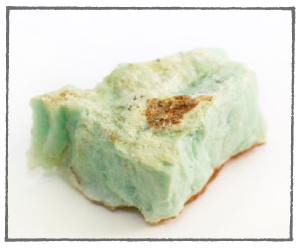CHRYSOPRASE

A VARIETY OF CHALCEDONY, chrysoprase gets its beautiful apple-green color from traces of nickel, and it is often located among nickel deposits as nodules. This highly valued form of chalcedony has been prized throughout history. Once mined heavily in Poland, it is also found in Australia, California, Brazil, Madagascar, and the Ural Mountains of Russia. Sometimes confused with jadeite, naturally colored chrysoprase is relatively rare; many examples on the market today are actually light-colored chalcedony that has been dyed.
The stone is thought to have been introduced to Europe via the Crusades and was very often misidentified at the time as an emerald. It was both carved into jewelry and crafted into goblets for several European churches, and some of these vessels were even thought to be the Holy Grail. It is also the symbolic stone of St. Thaddeus (more commonly known as St. Jude to modern Biblical historians). One legend surrounding chrysoprase is that Alexander the Great wore the stone into battle as protection—until it was stolen by a snake. In metaphysics, chrysoprase is used as a heart-healing stone, and it is thought to aid in numerous emotional ailments. It is associated with the Zodiac sign Libra.